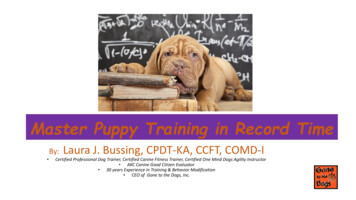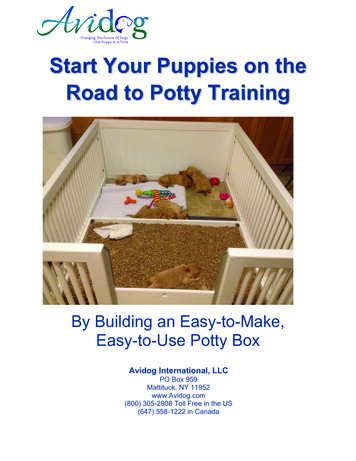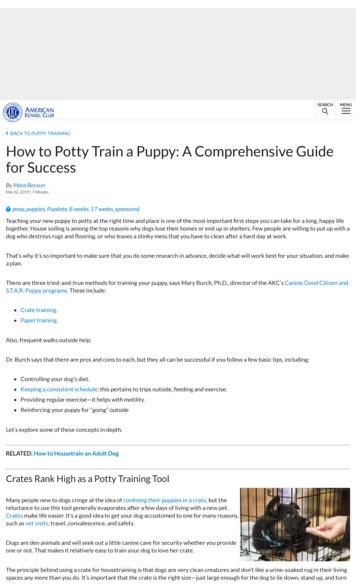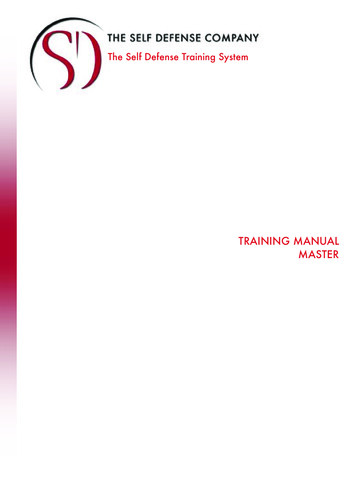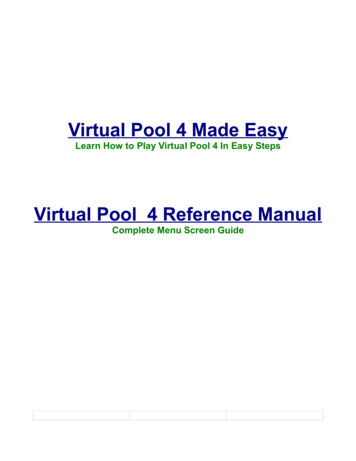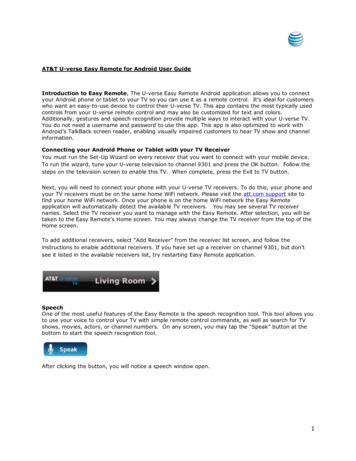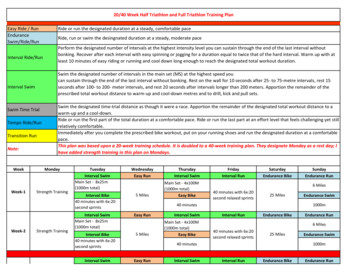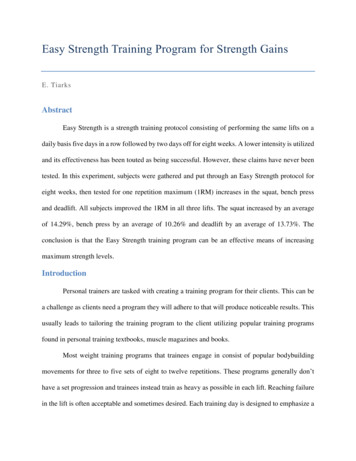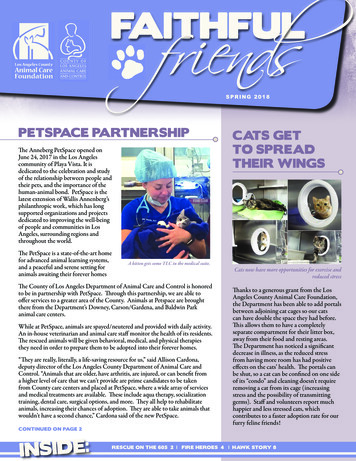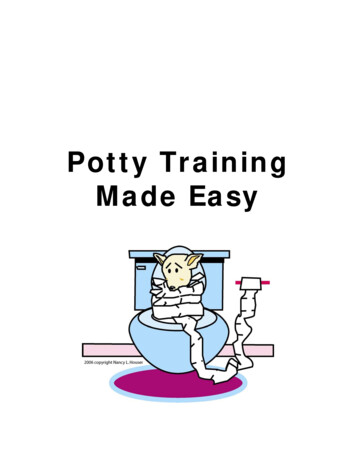
Transcription
Potty TrainingMade Easy
Potty Training Made EasyNo part of this publication may be reproduced or transmitted in anyform or by any means, mechanical or electronic, includingphotocopying and recording, or by information storage and retrievalsystem, without permission in writing from the publisher.The person who has purchased this material, is able to make a copyfor their computer, save on to a CD or print out the material.Requests for permission or further information should be addressedto;Sharda BakerPO Box 27. KewVic. 3101 Australiasharda@mydogbehaves.comPublished by Vinayak Enterprises Pty Ltdwww.MyDogBehaves.comRowville. Australia.Legal NoticesWhile all attempts have been made to verify information provided inthis publication,neither the author nor the publisher assumes any responsibility forerrors, omissions orcontrary interpretation of the subject matter herein.The publisher and author assume no responsibility or liabilitywhatsoever on the behalf of any purchaser or reader of the materialprovided.It is recommended you seek advice of your Vet in regard to anyhealth issues and before making changes to diet and or exercise. 2006 -2007. Vinayak Enterprises Pty Ltd. www.mydogbehaves.com2
Potty Training Made EasyTABLE OF CONTENTSINTRODUCTION. 4POTTY TRAINING METHODS . 6CRATE TRAINING . 6LITTER BOX TRAINING . 8PAPER TRAINING. 10POTTY PAD TRAINING . 12ON COMMAND . 13POTTY TRAINING IN EXTREME CLIMATES. 14POTTY TRAINING FOR A NEW PUPPY . 16WHEN TO START . 16PREPARING THE HOUSE. 17BASIC TRAINING PRINCIPLES TO KEEP IN MIND . 18POTTY TRAINING THE OLDER DOG . 20SPECIAL CONSIDERATIONS FOR OLDER DOGS . 20CRATE TRAINING FOR OLDER DOGS . 22TIPS FOR POTTY TRAINING OLDER DOGS . 23PLANNING FOR POTTY TRAINING . 25EQUIPMENT AND SUPPLIES . 25CRATE TRAINING . 25LITTER BOX TRAINING . 26PAPER TRAINING . 26CLEANING TIPS FOR SOILED AREAS . 27COMMON POTTY TRAINING PROBLEMS AND WHAT TODO . 29MESSING IN THE CRATE. 29MESSING IN THE HOUSE WHEN YOU ARE AWAY . 29TIME IN THE CRATE . 29FEED AND WATER SCHEDULES . 30RETURNING TO THE SAME SPOT TO URINATE IN THE HOUSE. 30MARKING TERRITORY . 30 2006 -2007. Vinayak Enterprises Pty Ltd. www.mydogbehaves.com3
Potty Training Made EasyCONCLUSIONS. 33INTRODUCTIONOne of the most exciting things that most dog lovers can imagine is bringinghome a new puppy or dog for the first time. Unfortunately, this excitementoften wears off quickly when the new little addition to the family begins usingthe house as a bathroom area. Fortunately, with a bit of consideration andunderstanding of some of the basic principles of potty training a dog, it iseasy and simple to teach your dog or puppy this very important behavior.There are some points to keep in mind when planning or starting your pottytraining routine. No matter which method you decide to use, there will beaccidents. Plan for them, accept them and move on with as little fuss andnegative actions or punishment towards the puppy as possible. Usually withpuppies, accidents are due to very small bladders and bowels and poorcontrol as their bodies develop, very similar to young human infants.Avoid punishing or reprimanding your puppy for an accident, as it is likely tobe more a fault of the owner for not taking the puppy to the potty area soonenough. Learn from mistakes and keep notes on when the puppy hasaccidents. Try to see if there is a pattern developing that can assist you inthe training, rather than become frustrated with the puppy. Virtually everypuppy wants to make his or her owner happy, and this can be used as aneffective motivator in potty training even young puppies.Older dogs that are being housebroken or potty trained for the first time willalso have accidents, until they understand what you want. Again, patienceand a positive attitude will help the training process. Remember that dogsaren’t aware of the value of antique rugs or wall-to-wall carpeting, ratherthey tend to relieve themselves where they feel they should - usuallysomewhere out of the way, like behind the couch or in the corner behind thepotted palm.There are many things that pet owners can do to make the process of pottytraining easy for their new dog or puppy. Good planning, an understanding ofthe potty training method to be used, plus other factors such as high qualityfood, lots of exercise, attention and love can all have a bearing on the timethat it takes to potty train your dog.It is also important to consider that some breeds are generally morechallenging to potty train than others. Smaller breeds, particularly some ofthe toy dogs, can be more difficult to train simply because they are so small 2006 -2007. Vinayak Enterprises Pty Ltd. www.mydogbehaves.com4
Potty Training Made Easyand they can easily slip under furniture or behind a chair and complete theirtoilet without even being noticed. With a little extra attention and effort thesebreeds can be potty trained successfully.Finally, each dog is different in personality and temperament. Some puppiesand dogs seem to almost potty train themselves where others, even from thesame litter, may require additional training but will soon learn what isexpected. 2006 -2007. Vinayak Enterprises Pty Ltd. www.mydogbehaves.com5
Potty Training Made EasyPOTTY TRAINING METHODSThere are several different potty training methods that can be used. Decidingon the best potty training method depends a lot on the age of the dog, thetime that you have to interact with the dog or puppy, and what method youare most comfortable with. Some of the potty training methods encouragethe dog or puppy to use an outside area to relieve themselves, whereasothers focus on containing the area the puppy or dog uses inside of thehouse - by the use of litter boxes, potty training pads or even newspapers.The following sections will outline each common method of potty training foreither a dog or a puppy, and will indicated the advantages and disadvantagesof each.CRATE TRAININGCrate training is one of the most effective ways to potty train a puppy or asmall to medium sized dog, as it uses the natural “denning instinct” of thedog to encourage it to keep the area that it sleeps clean and free from wastematerials. In the wild, the den is kept clean by the mother while the puppiesare young. Once they get older and are able to walk, they naturally gooutside of the living area or den to relieve themselves. In houses there areno dens, and the area is simply too large for puppies to feel that this is “theirspot”. By providing a den, in the form of a crate, the puppy will learn to waituntil he or she is taken outside before soiling in the crate.Crate training does required active participation and monitoring on the partof the dog owner. The following is an outline of how to complete a cratetraining routine: Purchase an appropriately sized crate, either plastic or wire, that islarge enough for the puppy to stand and stretch out comfortably. Make sure the crate is comfortable - use soft, washable liners or dogblankets. Sit with your puppy at the door of the crate. Place a small treat insidethe crate. Praise the puppy for going into the crate and getting thetreat. Let the puppy come out when he or she wants, do not close thedoor at this time. Only praise for going in the crate, ignore the puppy when he or she iscoming out. 2006 -2007. Vinayak Enterprises Pty Ltd. www.mydogbehaves.com6
Potty Training Made Easy When the puppy or dog walks into the crate say “Crate” or “Den” orwhatever word you wish to associate with going into the crate. When the dog is staying in the crate on their own to eat the treats,close the door for a few seconds, then open it up. Only praise whenthe dog goes in, never when it is exiting. Soon the dog realizes in isgood, out is neutral. After the puppy or dog is fine with being in the crate for more than afew minutes, put a chew toy in with the dog to keep it occupied. Tryvery slowly and gradually increasing your distance away from thecrate, and the time in the crate with the door closed. Since the puppy or dog will not eliminate when they are in the cratebecause it is their den, take them outside to eliminate when they comeout of the crate. After feeding, crate the puppy with a chew toy. In about 10-15minutes take the puppy out of the crate and to the designated toiletarea. Do not play or interact with the puppy at this time, simply takethem to the spot. If the puppy relieves itself, praise the puppy and spend some timeinteracting. If, after about 3-5 minutes the puppy has not toileted,return it to the crate, again without saying anything, for an additionalfive minutes. Repeat the process without interacting with the puppyuntil it goes to the bathroom. Praise and play always follow toiletingwhile crate training. At night, keep the crate in the bedroom or somewhere that you caneasily hear the puppy. If he or she whines, take them to the toilet areaand return them to the crate with as little interaction as possible. Justa simple “good girl” or boy will do when they toilet. Too much praisewill be seen as play, and may encourage the puppy to whinethroughout the night.The advantages to crate training include the fact that it uses the puppies ordogs natural instincts to help with the learning process. It minimizes thedangers of messes and accidents around the house when done correctly. Inaddition the puppy feels secure, and they can understand what is required ina relatively short time. 2006 -2007. Vinayak Enterprises Pty Ltd. www.mydogbehaves.com7
Potty Training Made Easy1Disadvantages to crate training are few, but the biggest one is that it willonly work if the trainer monitors the puppy closely while in the crate, andfollows the attention/inattention guidelines. Some owners may think thatcrate training is cruel, but this is simply not the case. Once peopleunderstand the crate is not used as a punishment but as a safe and secureplace for the puppy, they change their opinion quickly.LITTER BOX TRAININGPeople are very familiar with litter box training of cats, but many peopledon’t realize the same technique can be used with dogs. Simply because ofsize, this process works best with toy or small dogs, and is usually usedwhen people live in apartments or are unable to let their dogs outside atregular intervals. Litter box training can be used as a back-up plan if the dogmay need to be left in the house for long periods of time.Litter box training can be completed using the following strategies: Designate a spot in the house or apartment that is a litter box area. Anuncarpeted area is ideal, or simply lay some heavy plastic sheeting likepaint drop cloths under the litter box. 2006 -2007. Vinayak Enterprises Pty Ltd. www.mydogbehaves.com8
Potty Training Made Easy Use a bit of commercial kitty litter or shredded newspaper in thebottom of the box. When you notice the dog or puppy becoming agitated, whining, circlingaround or sniffing take them to the litter box and place them inside. If they don’t relieve themselves, take them out of the box and awayfrom the area until they start the behaviors again. When they relieve themselves in the box provide lots of praise. Some dogs and puppies will need to have the scent of the urine left inthe box until they understand that this is the toilet area.2The key to litter box training is that you have to actively be watching the dogor puppy around the times that you know that it will relieve itself. This isusually 10-20 minutes after eating, right after waking from a nap, or shortlyafter drinking water. Many dogs and puppies also have to urinate after orduring exercise periods. Watch for signs that your dog or puppy is suddenlydisinterested in the game and appears to be more engaged in sniffing aroundthe room; this is usually a sign that they will need to toilet.One problem with litter box training is that unlike a confined training methodlike crate training, you have no way to be in constant supervision of the dog.A way to overcome this is to keep the dog on a short leash, three to four feetat the most, and keep it attached to you at all times. While this may be a bitdifficult at first, it will help you monitor the dog or puppy at all times, and willallow you to know when to take it to the litter box. The same process can beused at night by tethering the dog to a piece of furniture in the bedroom andproviding a doggy bed or blanket to sleep on. When you hear the puppy ordog start to whine or move around, simply take them to the litter box andthen return them to the bed area. 2006 -2007. Vinayak Enterprises Pty Ltd. www.mydogbehaves.com9
Potty Training Made EasyThe advantage to litter box training is that it allows the dog or puppy torecognize where you what it to eliminate. A litter box can also be usedoutdoors to prevent difficult yard clean-ups.The major disadvantage to litter box training is that dogs, unlike cats, do notcover the waste with the litter. The dog litter box will quickly become veryfoul smelling if not cleaned as soon as the dog uses it. Some commercialpotty pads or even cat litter has deodorant in it, but this is usually notenough to cover the smell of the waste. Dogs that have been previouslytrained to only go outside to toilet may be very difficult to litter train, and itmay not be advisable to try this method with previously potty trained dogs.PAPER TRAININGPaper training is often a solution for those people that have to leave theirdog or puppy alone infrequently, but want to have the pet understand thatthere is a place to eliminate other than the carpet on the living room floor.Paper training with puppies follows the basic strategies similar to other pottytraining methods, in that it is designed to teach the puppy where to go, notto punish him or her for going in the incorrect location.Puppies quickly learn to associate a toilet area by how it feels to their feet.Once a puppy has been trained to eliminate on a particular surface type, theymay have difficulty transitioning to another surface. Paper training cansometimes make this easier, since it is easy to simply put paper downoutside and get the puppy or dog to go outside on the paper, as well as inthe house on the paper. 2006 -2007. Vinayak Enterprises Pty Ltd. www.mydogbehaves.com10
Potty Training Made EasyTo start a paper training program with your dog or puppy follow the stepsbelow: Designate an area of a tiled or hard floor surface of the house orapartment. It is not advisable to use this technique on a carpeted areaeven when covered with plastic, as the dog’s toenails will puncture theplastic and the urine will leak into the carpet. Cover this area with the type of paper you are planning to use. Mostpeople use newspaper or roll butcher paper. Make the area anappropriate size, so that it is about three to four times the size of thedog. Areas too small will not work for the dog physically, and areasthat are too large will take up more space and will be harder tomanage. A potty training pad can also be used in place of paper, and has theadded benefit of being treated with an attractant to encourage thepuppy to use the area. Allow several sheets of thickness to absorb the urine or fecal material. Monitor the dog or puppy very closely. At the first sign of agitation or sniffing around, circling or whining takethe dog or puppy to the papered area. Let them sniff around and praise them when they eliminate on thepaper. If they don’t use the paper within 3-4 minutes remove them from thearea and come back again and repeat the process. Keep constant supervision of the dog or puppy.3 2006 -2007. Vinayak Enterprises Pty Ltd. www.mydogbehaves.com11
Potty Training Made EasyPaper training often works best with small dogs and puppies, especially if thekennel that the puppy is from used papers. The biggest advantage to papertraining is that it is very inexpensive, and is easy to do wherever you maybe. Dogs quickly learn that paper equals toilet area, and this can be set upanywhere.The most obvious disadvantage is the odor that is associated with papertraining. No matter how careful the owner is, the urine and fecal matter willbe in contact with the floor surface, unless very heavy protective plastic isused between the floor and the paper. In addition, one if the advantages ofpaper training - the paper equals toilet area advantage - also becomes adisadvantage if newspapers are left on the floor beside a favorite readingchair!POTTY PAD TRAININGPotty training pads can be used in the same manner that paper is. They aremuch more effective at controlling odor and absorbing liquids than standardnewspaper.Potty training pads are sold in various sizes from relatively small to quitelarge. Basically they are similar to a disposable diaper in composition,although there is often a layer of liquid absorbing crystals inside the pad thatforms a gel when the dog urinates on the pad. This holds the liquid inside thepad and minimizes the tracking of the waste onto surrounding floor areas.The potty training pads also have a plastic backing that prevents damage tothe floor area beneath the pad. Like paper, they are simply placed in the dogtoilet area within the house. Many of the potty training pads also have achemical scent added to the potty pad to encourage the dog or puppy to usethe pad.4 2006 -2007. Vinayak Enterprises Pty Ltd. www.mydogbehaves.com12
Potty Training Made EasyON COMMANDTeaching your dog to urinate on command is not as difficult as it sounds, andis a wonderful behavior to teach both for house training or potty training forwhen you are traveling. The key to on command potty training is to monitorthe dog constantly, and be prepared to give praise and reward for doing theright thing at the right time.To start a program of on command toileting is relatively simple. The key is tocatch the dog just as he or she is about to urinate. As soon as you see theleg lift on a male dog or the squat of a female dog, give the command youwish to use. This can be “Get Busy”, “Tinkle” or “Toilet”. The command worditself is not important, but it should not sound like any other commands orthe dog will become confused. A word like “Go” should be avoided because itsounds too much like “No” and will lead to a problem with training. Alwaysmake sure everyone working with the dog is giving the same command. Youmay also want to consider the fact that you may have to give the commandwhen others are around, so make sure it is a not offensive word orsomething that is inappropriate to say in public.With the sign that the dog is going to urinate, the verbal command is given.Immediately after the dog finishes, there should be lots of praise and a treat.If the dog goes in the correct area before you give the command, don’tpunish or reprimand the dog, simply praise them for using the toilet area.The key to on command training is understanding when the dog isassociating your command with the act of relieving him or herself. If younotice the dog looks up at you in the toilet area, they are likely waiting forthe command to urinate. Be sure to praise, and give lots of treats when thedog urinates on command.Some points to keep in mind for on command training include: This works by pairing a natural behavior with a command, and themore frequently it is done, the quicker the dog will understand theconnection. Treats are very important, so buy some small sized good quality treatsand keep them with you when you are walking or outside with the dog. When first starting out, go to areas that are “attractive” to a dog forurinating, including areas where other dogs go. Learn your dog’s behavior by observing how they act before they haveto go - this will help you time the command. 2006 -2007. Vinayak Enterprises Pty Ltd. www.mydogbehaves.com13
Potty Training Made Easy Use the same spot as a toilet area until your dog is using the oncommand routine perfectly before using it in unfamiliar areas. Always praise the dog for a job well done, especially when they areoutside in new places. If the dog does not go on command do not punish them. Start back inthe familiar area and go slowly to giving the command in other areas.Usually on command training is only done after the dog has been pottytrained or during the process, when the puppy or dog understands the toiletarea, either inside or outside of the house.POTTY TRAINING IN EXTREME CLIMATESExtreme climates that are very wet, windy or cold may pose their ownchallenge to potty training a dog or puppy. Most pets, like humans, prefer tostay indoors on cold, wet, snowy and rainy days. Some breeds, especiallyminiature breeds, toy breeds, small dogs and those with very short coats orsingle coats will not want to go outside on those nasty days.If you know that you live in a cold or wet climate and are planning on gettinga puppy or dog, an excellent bit of advice is to try to time the arrival of yournew dog or puppy with the best possible weather conditions. This usuallymeans purchasing the puppy in the late spring or early summer, hopefullyleaving you several weeks to get the potty training completed prior to badweather setting in. However, this is not always possible, and often puppies ordogs come home in the worse weather conditions for potty training. Beloware some tips and strategies for potty training in cold or poor weatherconditions: Try to make potty training outside as short of a time period aspossible. Take the dog out and then return them to the house andreward and praise indoors, especially if the dog does not enjoy beingoutdoors. Don’t assume because you don’t like the weather the dog doesn’t.Many terriers, small dogs and even miniatures enjoy being outside forbrief amounts of time in the snow. Most breeds of dogs do not enjoythe rain but again, some breeds do. If your dog is extremely unhappy about going outside in the cold orrain consider an alternative toilet area of cold weather. Perhaps paperor litter training in the garage or carport area if you have a coveredarea may be more suitable and less out of the elements. Potty padsmay also be an option in cold climates and rainy conditions. 2006 -2007. Vinayak Enterprises Pty Ltd. www.mydogbehaves.com14
Potty Training Made Easy Be reasonable with regards to the temperatures your breed of dog canstand. Chihuahua’s simply cannot tolerate cold or wet so expecting thisbreed to go outside under bad weather conditions simply will not workand can cause the dog to become ill if it is forced to stay outside. Litter box training for small dogs may be an option for these smalldogs even if it is only used on bad weather days. Use the best possible weather to take the dog outside. You may haveto adjust feeding schedules over the winter months, to allow your petto eat and then eliminate when it is the warmest temperature. This isusually in the mid to late afternoon. Perhaps consider a warm doggy coat if you are crate training or pottytraining and have time to get the dog “dressed” to go outside and dohis or her business. They will need to adjust to having the garment on,and may initially take some time to get used to it, particularly puppies.Potty training in extreme climates is often just as difficult for the owner as itmay be for the puppy or dog. Keep to a schedule as much as possible withfeeding, exercise and play. Avoid changing your dog’s brand of dog food overthis time, as changing feeds can often result in diarrhea and other stomachproblems that will increase the dog’s need to make trips outside. 2006 -2007. Vinayak Enterprises Pty Ltd. www.mydogbehaves.com15
Potty Training Made EasyPOTTY TRAINING FOR A NEWPUPPYBringing a new puppy home from the kennel for the first time is a wonderfulexperience. A puppy starts learning about you and what you want on yourvery first contact, and it is important to start out on the right foot when itcomes to puppy potty training. Allowing bad habits to begin will only result inmore challenges to training the puppy, as he or she will have to both unlearnbad habits and re-learn desired behaviors. By starting with potty trainingright from the start, the puppy is better able to understand what you want,and will establish your relationship with the puppy as the leader.WHEN TO STARTPuppies will usually be removed from their mother’s care and given to newowners when they are between six to eight weeks of age. Puppies, even thisyoung and small, can begin to be potty trained from the moment that theyarrive at your house. Puppies at the age of less than ten weeks usually willneed to either urinate or defecate every two to three hours. By taking yourpuppy outside prior to these time limits, the puppy will learn to relieve him orherself outside, and will also become comfortable with the feel of the lawn orconcrete under their feet when they are relieving themselves. This is bigcomponent of potty training a puppy, as they will begin to associate the feelof the ground surface outside with going to the bathroom, and the surface ofthe floor inside as playing and resting - but more importantly not toileting.If you are able to prevent the puppy from having accidents in the house, heor she will not develop the habit, and will be much easier to potty train thana puppy that is allowed to soil in the house initially and then potty trainedlater.It is important to remember that puppies, like babies, have very smallbladders and stomachs and have poor muscle control. They cannot beexpected to walk far or delay having to go, so proper house preparation isimportant. 2006 -2007. Vinayak Enterprises Pty Ltd. www.mydogbehaves.com16
Potty Training Made EasyPREPARING THE HOUSEIn order to make potty training your puppy as easy as possible, there are afew changes that can be made to the house to simplify the process for bothyou and the puppy. The following tips can make potty training, whether cratetraining, litter box training, or paper or potty pad training easier for allinvolved: Control the area that the puppy has access to. This means installingpuppy gates at doors, using a crate, purchasing a indoor puppy pen orkeeping your puppy on a leash that is either attached to a piece ofheavy furniture or even better, attached to you. This prevents thepuppy from sneaking off into the other room to eliminate,, or fromgetting behind furniture to do their business. If your puppy area has lots of items on the floor you may wish toremove them and keep the room as uncluttered as possible. Clutter isa perfect place for the puppy to slip behind to use the toilet. Consider keeping your puppy confined to an area that has no carpet.Anticipate accidents and prepare for them. Cleaning up on tile orlinoleum surfaces is much easier than cleaning carpet. Have the puppy area relatively close to the exit or door that you willneed to take the puppy through to go outside, and keep this exitconsistent. If the puppy area is on the other side of the house from thedoor, there is a greater chance that tiny bladders will lose control asyou are making for the door. With the puppy area close to the door,the time between the signs of needing to go outside and actuallygetting outside will be much shorter.Remember that safety is also important. Don’t have the puppy rushing up ordownstairs to go outside as they can hurt themselves in the hurry. Inaddition if you are leashing the puppy, only allow 3 to 4 feet for the leashand monitor them constantly to avoid any chance of them choking orchewing on the leash and choking on the parts. 2006 -2007. Vinayak Enterprises Pty Ltd. www.mydogbehaves.com17
Potty Training Made EasyBASIC TRAINING PRINCIPLES TO KEEP INMINDAs a new puppy owner, there are some basic training principles that can behelpful in working with even a very young puppy when potty training. One ofthe biggest considerations is that you are working to mold or shape apuppies behavior, and this takes time. It would be unreasonable to expect ababy to be potty trained the first time you put them on the toilet, and it isunreasonable that a puppy will the potty trained the first time you take themoutside, put them in the litter box or placed them on the potty pad ornewspaper. Patience and constant monitoring of the puppy is what is neededto make this process as stress free as possible for both you and the puppy.The following basic principles for potty training can be kept in mind to helpmodify what you may be doing to make it work for you and your puppy: Different breeds mature both physically and behaviorally at differentrates. Don’t assume that every puppy will hit the same
training easy for their new dog or puppy. Good planning, an understanding of the potty training method to be used, plus other factors such as high quality food, lots of exercise, attention and love can all have a b
